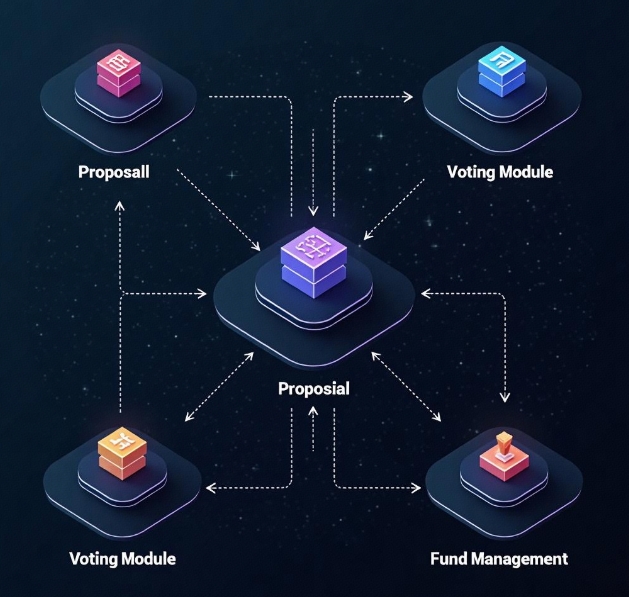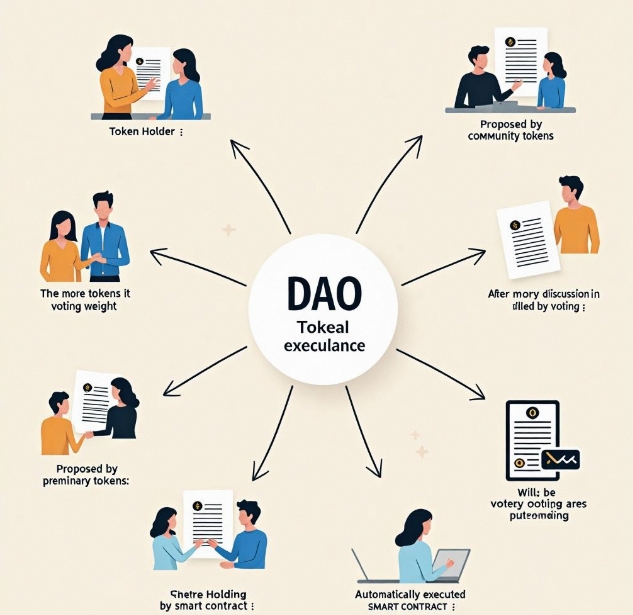DAO system development practice: key points of governance contract design
- latest articles
- 1.DApp Development & Customization: Merging Diverse Market Needs with User Experience 2.Analysis of the Core Technical System in DApp Project Development 3.How to achieve cross-chain interoperability in Web3 projects? 4.How does the tokenization of points reconstruct the e-commerce ecosystem? 5.How to Set and Track Data Metrics for a Points Mall? 6.What is DApp Development? Core Concepts and Technical Analysis 7.Inventory of commonly used Web3 development tools and usage tips 8.Development of a Distribution System Integrated with Social E-commerce 9.Six Key Steps for Businesses to Build a Points Mall System 10.What is DApp Development? A Comprehensive Guide from Concept to Implementation
- Popular Articles
- 1.Future Trends and Technology Predictions for APP Development in 2025 2.Analysis of the DeFi Ecosystem: How Developers Can Participate in Decentralized Finance Innovation 3.From Zero to One: How PI Mall Revolutionizes the Traditional E-commerce Model 4.DAPP Development | Best Practices for Professional Customization and Rapid Launch 5.Recommended by the Web3 developer community: the most noteworthy forums and resources 6.From Cloud Computing to Computing Power Leasing: Building a Flexible and Scalable Computing Resource Platform 7.How to Develop a Successful Douyin Mini Program: Technical Architecture and Best Practices 8.Shared Bike System APP: The Convenient Choice in the Era of Smart Travel 9.How to Create a Successful Dating App: From Needs Analysis to User Experience Design 10.From Design to Development: The Complete Process of Bringing an APP Idea to Life
Decentralized Autonomous Organizations (DAOs) are one of the significant innovations in blockchain technology. DAOs utilize smart contracts to achieve self-management and decision-making, eliminating intermediary roles found in traditional organizations, thereby making the governance process more transparent, efficient, and decentralized. The governance contract, as the core component of a DAO system, undertakes crucial functions such as decision-making, fund management, and member management. The quality of the governance contract's design directly determines the stability, security, and efficiency of the DAO system.
In this article, we will explore the key design points of governance contracts in DAO system development, analyzing their functional requirements, design principles, common issues, and best practices to help developers achieve efficient, secure, and scalable governance mechanisms when building DAO systems.
1. Overview of Governance Contracts
The governance contract is one of the core smart contracts in a DAO system, responsible for managing and executing governance rules within the organization. All decisions in a DAO are implemented through the governance contract, including proposal submission, the voting process, and proposal execution. The governance contract not only serves as the operational hub of the DAO but also directly determines the organization's degree of decentralization and governance efficiency.
Governance contracts typically include the following key functions:
Member Management: Determines which users are eligible to participate in governance, voting, etc.
Proposal Management: Allows members to submit proposals and undergo approval processes.
Voting Mechanism: Members participate in proposal voting based on their rights to decide whether a proposal passes.
Fund Management: Handles the flow and distribution of funds within the DAO.
Execution Mechanism: Automatically executes decisions or instructions based on voting results.
A well-designed governance contract should possess scalability, flexibility, and sufficient security to ensure the DAO can operate continuously and remain stable in the face of external attacks or internal disagreements.
2. Key Design Points for Governance Contracts
When designing a governance contract, multiple aspects need consideration, including the contract's functional requirements, the rationality of the governance mechanism, and the contract's security. Below are some key points in governance contract design.
2.1 Modular Design of Governance Contracts
To improve the maintainability and scalability of the contract, governance contracts should adopt a modular design. Modular design divides the governance contract into multiple independent functional modules, each responsible for handling specific functions such as voting, proposals, and fund management. This design approach not only makes the contract clearer but also allows for independent upgrades or replacements of specific modules when needed.
Common governance contract modules include:
Voting Module: Responsible for creating proposal votes, counting votes, and executing results.
Proposal Module: Responsible for the submission, review, and storage of proposals.
Fund Module: Responsible for managing DAO funds, including deposits, transfers, and distributions.
Permission Module: Manages member permissions, including voting rights, proposal rights, fund management rights, etc.
Through modular design, developers can implement specific functionalities in different modules, avoiding overly complex single contracts that are difficult to maintain or extend.
2.2 Management of Members and Voting Rights
The core of a DAO lies in decentralized governance; therefore, the design of member management and voting rights is crucial. The governance contract needs to clearly define who are legitimate members of the DAO and how voting rights are granted or revoked.
Common member management methods include:
Token Holders: DAO members gain governance participation eligibility by holding tokens. The amount of tokens held determines the member's voting weight.
Authentication Mechanism: Governance participation rights can be determined through identity verification or community contribution levels.
The allocation of voting rights is also a key focus in governance contract design. Common voting right allocation methods include:
One Token, One Vote: Each token held grants one voting right.
Weighted Voting Rights: Voting power is determined based on factors such as the number of tokens held and the duration of token staking.
The design of voting rights needs to consider fairness, decentralization, and incentive mechanisms to prevent certain members from monopolizing governance power through large token holdings or other means.
2.3 Proposal and Voting Mechanisms
Proposals and voting are among the core functions of a governance contract. The proposal mechanism determines how DAO members can present their opinions or plans, while the voting mechanism determines how proposals gain support and are ultimately executed.
A good proposal mechanism should meet the following conditions:
Proposal Submission: The contract should allow any qualified member to submit new proposals. Submission thresholds can be set, such as requiring the proposer to hold a certain number of tokens or gain a certain level of support.
Proposal Review: To prevent malicious proposals, the contract should implement a review mechanism. This can be automatic or decided through member voting.
Voting Period: To avoid proposals stagnating, the governance contract needs to set a voting deadline. Once the voting period ends, the contract automatically calculates the results.
Voting Weight: As mentioned earlier, voting weight can be calculated based on factors like token quantity and holding duration to ensure the fairness of voting outcomes.
For the voting mechanism, some common voting methods include:
Simple Majority Vote: A proposal passes if it receives more than half of the votes in support.
Weighted Voting: Voting power is determined by the number of tokens held by the voter.
Ranked Choice Voting: Allows members to rank multiple proposals, with the final decision based on the rankings.
The governance contract should ensure the transparency and fairness of the voting process, avoiding human intervention or the impact of system vulnerabilities.
2.4 Proposal Execution and Fund Management
Proposal execution is the final step in DAO governance contracts, determining whether voting results can be translated into actual operations. The execution mechanism should ensure that the contract can automatically and accurately perform operations based on voting results, minimizing the possibility of manual intervention.
In terms of fund management, governance contracts typically need to manage the DAO's treasury. Treasury management includes:
Fund Storage: Ensures the security of DAO funds, preventing malicious transfers.
Fund Allocation: Distributes funds according to governance outcomes, such as paying developer rewards or supporting community activities.
Fund Usage Restrictions: Prevents misuse of funds; the governance contract can set conditions for fund usage, such as allowing only specific proposals to allocate funds.
Automating proposal execution and fund management through smart contracts can significantly enhance the operational efficiency and transparency of a DAO.
2.5 Security and Attack Resistance
The security of the governance contract is another critical consideration in its design. DAO system governance contracts often involve substantial funds and decision-making power; any contract vulnerability could lead to irreversible losses. Therefore, when designing a governance contract, the following security measures must be considered:
Reentrancy Attack Protection: Ensures the contract can prevent common vulnerabilities like reentrancy attacks during operations such as fund transfers.
Timestamp and Block Height: Uses blockchain timestamps and block heights to limit the validity period of votes, preventing hackers from manipulating time to influence voting.
Contract Upgrade Mechanism: DAO systems often need upgrades as requirements evolve. Contract upgrades should consider security to ensure new contracts do not introduce new vulnerabilities.
Developers should conduct thorough security audits and perform extensive testing before release.
3. Best Practices for Governance Contract Design
3.1 Transparency
DAO systems emphasize decentralization and transparency. All operations of the governance contract should be open and transparent, allowing any member to view information on proposals, voting, fund usage, etc. The contract should publicly disclose all historical records, ensuring every member can clearly understand the organization's decision-making process.
3.2 Upgradability
As DAOs evolve, governance mechanisms may require adjustments. The contract should be upgradable, allowing developers to perform upgrades when necessary without affecting the existing governance structure. Common upgrade solutions include proxy contract patterns and separation of data storage from logic contracts.
3.3 Incentive Mechanisms
The success of a DAO relies on effective incentive mechanisms. The governance contract should design reasonable incentives to encourage members to actively participate in proposals and voting. For example, rewarding tokens or increasing DAO governance weight can incentivize members to contribute ideas and time.
4. Conclusion
The governance contract is the core of a DAO system, directly impacting its decentralization, decision-making efficiency, and security. Designing an efficient and secure governance contract requires thorough consideration of member management, proposal and voting mechanisms, fund management, security, and other aspects. As DAOs continue to develop, the design of governance contracts should also be continuously optimized and refined to adapt to evolving needs and challenges.
-

How to achieve cross-chain interoperability in Web3 projects?
With the continuous development of WEB3 technology, Web3 has gradually become an···
-

Inventory of commonly used Web3 development tools and usage tips
With the continuous development of blockchain technology, Web3 has become a hot ···
-

Web3 development trend prediction: analysis of future technology directions and application scenarios
With the gradual development of blockchain technology, the concept of Web3 has m···

 Blockchain
Blockchain












